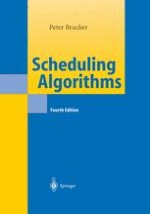2004 | OriginalPaper | Chapter
Changeover Times and Transportation Times
Author : Professor Dr. Peter Brucker
Published in: Scheduling Algorithms
Publisher: Springer Berlin Heidelberg
Included in: Professional Book Archive
Activate our intelligent search to find suitable subject content or patents.
Select sections of text to find matching patents with Artificial Intelligence. powered by
Select sections of text to find additional relevant content using AI-assisted search. powered by
In this chapter we consider scheduling problems in which the set I of all jobs or all operations (in connection with shop problems) is partitioned into disjoint sets Il,... , I r called groups, i.e. I = Il ∪ I2 ∪ ... ∪ I r and I f ∩ I g = Ø for f, g ∈ {1,... , r},f ≠ g. Let N j be the number of jobs in I j . Furthermore, we have the additional restrictions that for any two jobs (operations) i, j with i ∈ I f and j ∈ I g to be processed on the same machine M k , job (operation) j cannot be started until s fgk time units after the finishing time of job (operation) i, or job (operation) i cannot be started until s gfk time units after the finishing time of job (operation) j. In a typical application, the groups correspond to different types of jobs (operations) and s fgk may be interpreted as a machine dependent changeover time. During the changeover period, the machine cannot process another job. We assume that s fgk = 0 for all f, g ∈ {1,... ,r}, k ∈ {1,... , m} with f = g,and that the triangle inequality holds:9.1 $${s_{fgk}} + {s_{fhk}}{s_{fhk}}\,for\,all\,f,g,h \in \{ 1,...,r\} ,k \in \{ 1,...,m\} .$$
